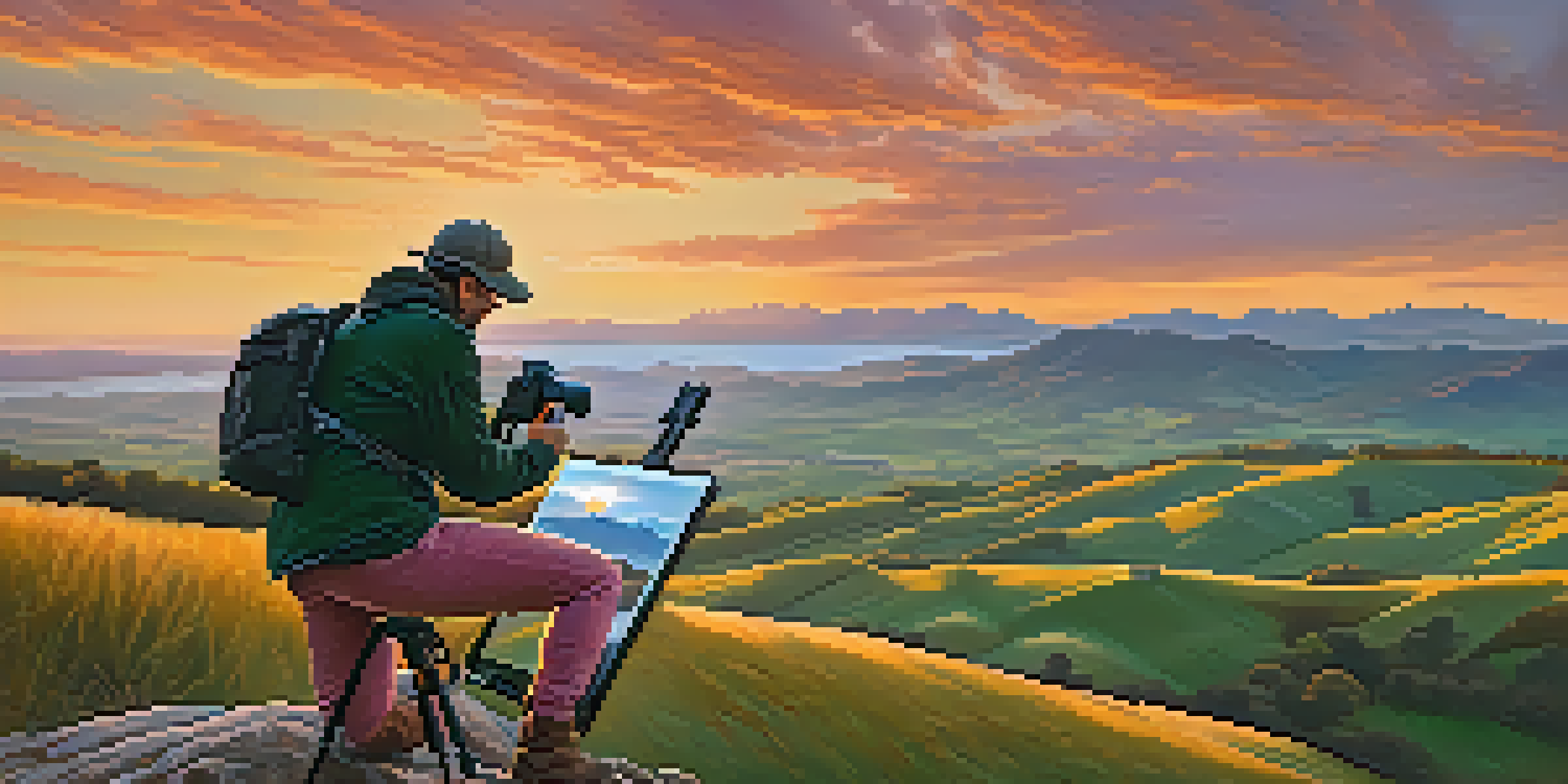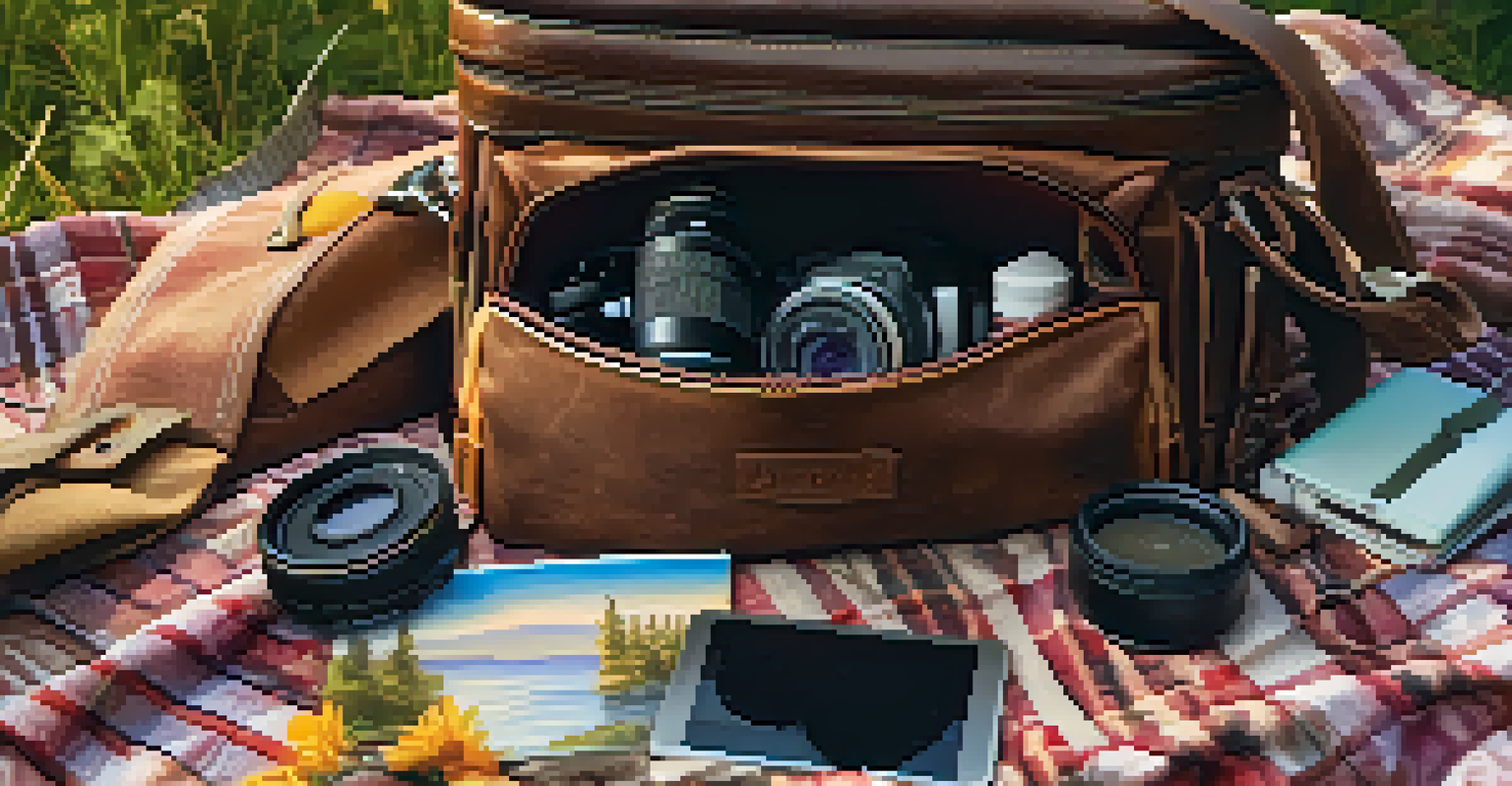The Ultimate Packing List for Travel Photographers

Essential Camera Gear for Every Trip
When it comes to travel photography, your camera gear is your lifeline. Start with a reliable camera that suits your style—DSLR, mirrorless, or even a high-quality compact. Don’t forget extra batteries; nothing kills the mood faster than a dead battery at a breathtaking sunset.
Photography is the story I fail to put into words.
Lenses are equally important; bringing a versatile zoom lens can cover a range of scenarios, from landscape to portraits. For those who love detail, a prime lens can add beautiful sharpness to your shots. Consider packing a lightweight tripod as well—perfect for those long exposure shots, especially in low-light situations.
Finally, invest in a solid camera bag. It should provide enough protection for your gear while being comfortable to carry. A bag with customizable compartments will help keep your lenses and accessories organized, making it easier to grab what you need on the go.
Must-Have Accessories for Photographers
Accessories can make a significant difference in your photography experience. Start with a good quality memory card that has ample storage; running out of space while capturing the perfect moment is a nightmare. It’s wise to carry multiple cards and a card reader for easy backups.

A lens cleaning kit is another essential; dust and smudges can ruin your shots. Keep a microfiber cloth and a blower handy to ensure your lens is always crystal clear. Additionally, a portable external hard drive can be a lifesaver for backing up your images while on the road.
Essential Gear for Travel Photography
A reliable camera, versatile lenses, and a sturdy bag are crucial for capturing stunning travel moments.
Lastly, don’t overlook a comfortable camera strap. Whether it’s a neck strap or a sling, having something that feels good while you shoot is crucial. It allows you to focus on capturing moments without the distraction of discomfort.
Clothing Considerations for Travel Photographers
When packing clothing for your photography adventures, think comfort and practicality. Opt for layers that can be easily added or removed based on the weather. Quick-dry fabrics are great for those unexpected rain showers, while breathable materials keep you cool during hot days.
The best camera is the one you have with you.
Also, consider the locations you’ll be visiting. If you’ll be hiking or wandering through urban settings, sturdy footwear is a must. A good pair of hiking boots or comfortable sneakers can make all the difference, allowing you to explore without sore feet.
Lastly, don’t forget about accessories like hats and sunglasses. These not only protect you from the elements but can also add character to your travel photos. Plus, they keep you looking stylish while you shoot!
Tech Essentials for Editing on the Go
Editing your photos while traveling can be a delightful way to relive your adventures. A lightweight laptop or tablet is essential for this, and you should ensure it has enough power to run your preferred editing software. Many photographers love using Adobe Lightroom for its user-friendly interface and powerful features.
Portable hard drives are crucial for storing your work as you go. They provide extra space and a backup for your precious images, which is especially important if you’re working with large files. Look for rugged models that can withstand the rigors of travel.
Editing and Backup Essentials
Having a lightweight laptop and portable hard drives is vital for editing and safeguarding your photos on the go.
Don’t forget your power adapters and possibly a portable charger. Keeping your devices charged ensures you can edit whenever inspiration strikes, whether in a café or on a long train ride.
Safety Gear for Protecting Your Equipment
Safety should be a top priority for any travel photographer. Invest in a durable camera bag that offers padding and weather resistance. This not only protects your gear from physical damage but also shields it from rain and dust.
Consider using lens caps and body caps when your camera isn’t in use. These small accessories can prevent dust and scratches, keeping your equipment in top shape. Additionally, a UV filter can protect your lens from scratches and improve image quality.
Finally, think about insurance. Whether it’s travel insurance that covers your gear or specialized camera insurance, it’s better to be safe than sorry. Knowing your equipment is protected allows you to focus on capturing amazing shots instead of worrying about what might happen.
Planning Your Shooting Schedule
A well-planned shooting schedule can enhance your travel photography experience. Research your destination beforehand to identify key locations and the best times to shoot. Golden hour—just after sunrise or before sunset—offers the most flattering light for photography.
Don’t forget to account for travel time between locations and potential weather changes. Sometimes the best shots come from unexpected moments, so leave some flexibility in your schedule to explore on a whim. This balance between planning and spontaneity can lead to some of your most memorable photos.
Plan for Flexibility in Shooting
Creating a shooting schedule that balances planning with spontaneity can lead to memorable and unique photographic experiences.
Lastly, remember to take breaks. Over-scheduling can lead to burnout, and you might miss those quiet moments that are just as important as the iconic shots. A relaxed photographer is a more creative photographer!
Final Tips for Travel Photography Success
As you prepare for your journey, keep in mind that travel photography is about telling a story. Focus on capturing not just the landscapes, but also the emotions and experiences that come with them. Each photo should reflect the essence of your adventure.
Engage with the locals and immerse yourself in the culture; this can lead to unique photo opportunities that you might not find in guidebooks. A candid shot of a local market or a friendly interaction can add depth to your portfolio.

Finally, have fun! Capture the moments that resonate with you, and don’t put too much pressure on yourself to get the perfect shot. Sometimes the best stories come from the unexpected, so embrace the journey and enjoy the process.